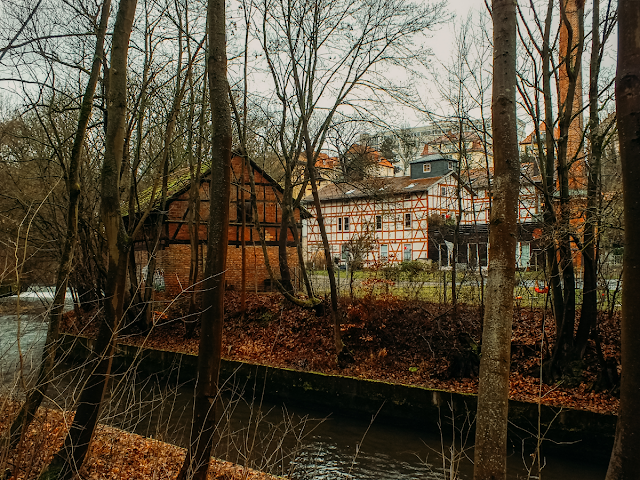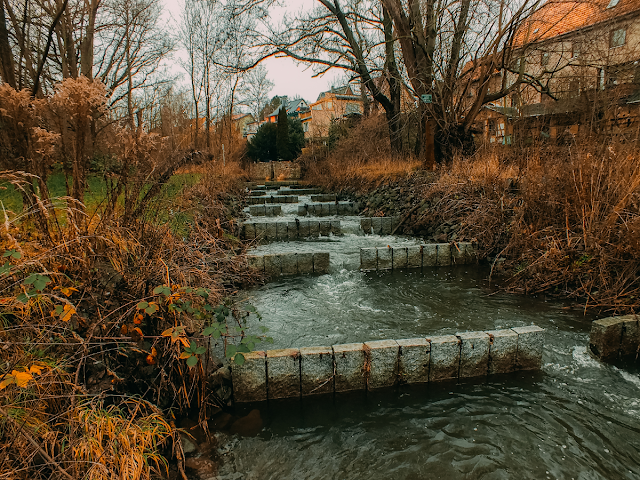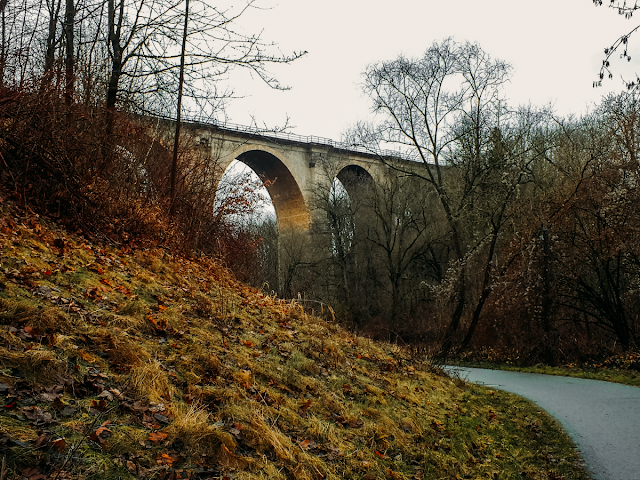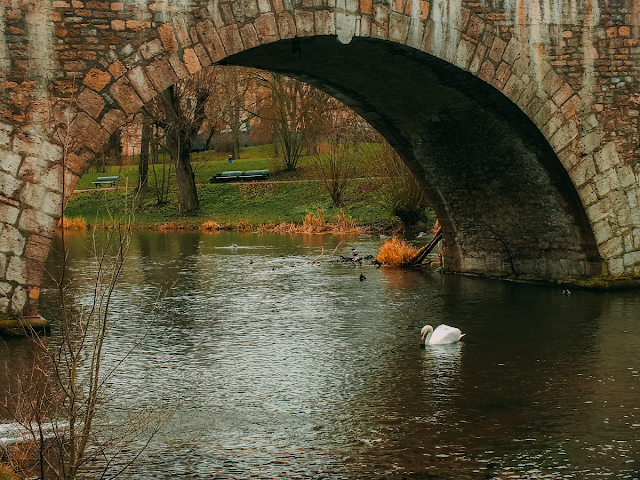the historic karlsmühle ( an ancient mill ) in weimar.
on the second christmas day, before i headed home to wiesbaden again, my parents and i went for a final walk in weimar. it was a short one that lead us from weimar along the river ilm to one of its outer quarters, tiefurt, and back. it was a cold and grey day, but i remember not minding at all, rather enjoying the chill and taking in all the bare nature. when the trees are stripped off their leaves it clears the view on your surroundings, reveals formerly unseen buildings, opens up perspectives that you wouldn't probably see on a summer day because its hidden underneath all the green leaf dresses of the trees. while winter isn't my most favourite season of the year it does at least have some benefits i can appreciate and that is one of them. getting those undisguised insights. discovering the raw beauty when every natural attachment has rotted away and uncovers cracks and moss and decay, highlighting patterns and structures and concealed spots that you've passed by countless of times without noticing or thinking about their existence and pertinence.
winter can be an ugly season. but even ugliness and unseemliness possesses a peculiar fascination, a fascination that's not always easy to subdue. it can bring you to a certain realization - that it is part of making life worthwhile, too. i often think about how attractive the hideous and unsightly things are, as it makes me recognize or even identify myself with them! because isn't it some truth that, when you strip yourself bare and are left with your deepest core basically on the outside of yourself, it is an opportunity to accept it all, the ugly and the monstrous, the decaying and the stalling parts of your being? and is this realization able to guide to a perception of beauty perhaps? a beauty that lies in the fraying and unraveling and dereliction and disintegration...

... such as with the falling apart of a centuries old mill...
along the ilm river, passing by the e-werk - a non-operative former electric power station ( built in 1897 ). it's a place of cultural importance now, housing a small repertory cinema- the lichthaus, a secondary venue of the german national theater and some workspaces for creative people.
the cooling tower was built out of wood, which always felt kind of strange to me. i guess when i have cooling towers in mind i always keep conjuring up an image of either concrete or steel constructions.
the ilm river has a few barrages in the whole urban area of the city. this one was close to the vereinsmühle ( association mill ), which you can see a tiny part of at the right corner of the image.
the ilm is flushing around a tiny islet in the river, on which some more old buildings are situated, probably at one point having been part of the mill complex.
a little better view on the mill building in the back. the current structure was erected in 1845, but a mill has existed at this location dating back to 1375. wouldn't it be interesting to see how this building and its surroundings changed over all these centuries? i certainly would like to go back in time and learn the history of it and the people who kept it going and rebuilding it during its long history. these days it's a residential building - and if i had the means and the luck that goes with it, this would be a place i would want to live in for sure.
close nearby is this train bridge - the ilmviadukt ( also called sechsbogenbrücke ). this bridge with its impressive six arches is weimar's tallest - spanning the ilm valley with a length of 155 and a height of 37,5 meters. it was opened for train traffic in 1876. it also is one of the most sad places i have ever encountered - directly underneath the bridge you can find several commemoration crosses for people who jumped into their death here.
in a bout of melancholy i registered that this place was actually a beautiful place to say goodbye to the world.
standing directly underneath the bridge you got a feeling of smallness and insignificance.
but it also made you stand in awe and appreciate the dimension of it.
moving forward we stumbled upon some abstract looking forest furniture, probably serving as a resting area for the walkers, runners & cyclists using the promenade.
arriving in tiefurt. tiefurt is a small village in the north-east of weimar and it is known for its palace that once has been one of the many muse courtyards of the enigmatic duchess of saxe-weimar-eisenach anna amalia. many poets and painters, well-known musicians and other illustrious persons where guests in that palace, inspiring them to create important pieces of german culture. we decided against visiting the palace, though, my time in thuringia was coming to a close, there was simply no time anymore. we just spent a few more minutes at this barrage which made me wish i could move into the little house with the big window and then we headed back to weimar again.
spotted the cutest little pavilion on the other side of the ilm river!
close-up of the pavilion. must be a splendid place in the summer to watch the river and relax with a good book or have a picnic at.
a fish pass - it is supposed to lead fish away from a mill race that's used for energy extraction into the main river bed of the ilm.
returning to the ilmviadukt.
the river always close to the promenade.
the ilm river is weimar's biggest river ( the whole river is 134,9 kilometers long ) and one of thuringia's most important ones, too. it's a tributary to the much bigger saale river and drains an area of about 1043 cubic centimeters in central thuringia. in many places the river is a very naturally meandering body of water, making it one of the most romantic rivers in thuringia as well.
one of the memorial crosses underneath the bridge. i hope that the person who died here is not forgotten, even though the place looked like it.
on the other side there was a better kept gravesite.
returning back to weimar we found some more of these curious-looking resting areas. i am pretty sure they are also used for fitness-related things.
the goethe & schiller archive. ( you can find more about this building in one of my latest blogposts. )
i like the structure of the terrace construction of the archive.
the sternbrücke in front of the city palace ( seen on the right ) is one of the most gorgeous bridges in weimar. it was built between 1651 and 1654 by the architect johann moritz richter, the elder. it's a pedestrian bridge, no cars are allowed on it.
naturally, the area around the bridge is always full of water birds waiting to be fed by humans.
when the ilm river carries a lot of water you can watch a curious spectacle: the ducks often let themselves 'raft' down the river under big gaggling and twittering. it's actually super funny! the swans are sometimes getting real close, and i do have a lot of respect for them, as they are such big birds and known to sometimes attack people ( especially when they have young ones ).
the tiny leutra creek is a small side arm to the ilm river. the creek is only a few meters long, its source is enclosed in a grotto guarded by a sphinx. because of the leutra flowing underneath this arch of the bridge, the arch is called leutrabogen.
back to the ilm with a view on the 'reithaus' - a former riding hall built in 1718 by christian richter. today this building is an international meeting place for adolescents.
i always felt drawn to this building whenever we visited weimar in the past, there's just something so pretty about it. in its past it's not only served as a riding school, but it's been a theater venue, teaching space of the bauhaus university and a GDR youth club! i remember my mom always telling me about going there often to meet with friends and be part of the activities that were offered to kids coming there.
the bastille & the schlossturm - the oldest parts of the weimar city palace. it dates back to the 1430ies and survived 2 big fires. johann sebastian bach was one of its most famous inhabitants - involuntarily that is, he was incarcerated due to taking a new job under the protection of a different territorial ruler without the approval of his then employer wilhelm ernst of saxe-weimar.
in front of the german national theater - with goethe and schiller watching over the people passing by. the steel construction floating above them is part of the ice rink standing in front of the theater every year around christmas and new year's. definitely a gorgeous place to strap some ice-skates under your feet and sashay a few rounds!
a GDR relict being modernized - 'langer jakob'. the tall jakob was built between 1970 and 1972 for weimar's university students and offers very moderately priced housing! it was designed and probably also built by the GDR's first female professor for architecture - anita bach. for years it deteriorated bit by bit and i was slowly wondering when they would eventually tear it down and destroy another piece of GDR architecture. in 2017 they started to renovate the high-rise and when i revisited in 2019 it was almost completed! i loved the patterns on the facade already. next time i'll visit weimar i am curious to see if they also managed to renovate the student's club on the first floor.
another modern building, but at its core older than the one prior, is the shopping mall 'atrium'. first constructions actually began in 1937 in the course of the monumental undertaking of building a regional district forum under the nationalsocialist regime. while some parts of the gauforum weimar got built and completed, this hall, which was supposed to be dedicated to the national community, was laid to rest in 1944. until 1969 the concrete and steel construction stood as a memorial against the nazis at this spot, before the GDR authorities began thinking of plans for further development. from 1973 to 1976 they converted the structure into a multi-purpose hall and later often used it as depot and for offices. in 2004 they decided to revive the shabby building and turn it into a shopping mall, which was opened up in 2005. i can't remember the old multi-purpose hall at all, even though i have been to weimar countless of times, from my early childhood on and therefore must have visited it at some point or another. strange how memory deletes some things entirely off your brain. especially strange since when i look at old pictures now, i wish i would've conciously taken in the building, as it was kinda cool with its GDR charme and curtain-wall facing. that original building doesn't seem to be lost, though, when they revived it, they cladded the whole thing with mirror glass & transparent fabrics so you can still make out the original facade when you look close enough. all in all, though, i really think that as of today it is kind of boring and bland architecture, only the paintings on the fabric make it sort of worthwhile to look at! on this side of the atrium you can see manet's 'luncheon on the grass', on the other side da vinci's 'lady with an ermine' is greeting people coming from the east ( i especially always loved that painting - but i did not take a photo of it this time around ).
it's kind of odd, though, that if the original constructions would have been completed, this area would have served as a glorification of nationalsocialism, which leaves a bitter taste in my mouth now that a shopping mall stands on these historical grounds. i feel like the authorities of weimar could've used the chance to create something more out of this hall, a museum for example that would look at the megalomaniac construction more critically and shine a light on the horrors of the nazi era, but instead they opted to kind of 'glamourize' the area by building a temple of consumerism. recently though, they started to finally process the history of the whole ensemble that was built by the hands of forced laborers and prisoners of war and offer more and more exhibits and background knowledge on the premises. that at least brings with it some self-reflection on the heavy legacy of the architecture that destroyed an entire quarter of the city with its construction.
well, at the end of this post all that is left to say is, that weimar of course is comprised of much more interesting places, not just the tiny snippets i posted about today. it's a culturally irreplaceable city after all! hopefully i get to show you more parts of the city in the future, i miss this town terribly and want to explore its streets over and over again. i am pretty sure by now that it even has more to offer than what i remember from my childhood and i really would like to uncover more of its secrets. when i was young, weimar was my favourite place on earth and it's always been a dream of mine to move to this city and bask in its glorious history. it's also not too big of a city ( around 65.000 inhabitants ), very walkable with a dense amount of historically unique architecture and many palaces dotting the neighbourhoods. i also always thought that the city was a lot more open-minded and liberal than any other city in thuringia, and i still think of it that way today sometimes, though i know that erfurt and jena are buzzing cities as well. since i am not a local anymore, though, i can't really put a stamp on it, and since every city carries with it a darker hidden part, i won't claim that it is 100 percent true. it's a fact, though, that due to it being a city with a university, more open ideas and innovative concepts are floating through the air here, giving the place an exciting and bubbling atmosphere. and when you need a little more calm and quiet, the little sleepy villages and wonderful nature orbiting the city are perfect for that as well! many of the outer city districts boast a palace or a castle, which makes a visit even more worthwhile in my opinion. a visit to weimar and the surrounding areas is simply a must in my opinion!

































Comments